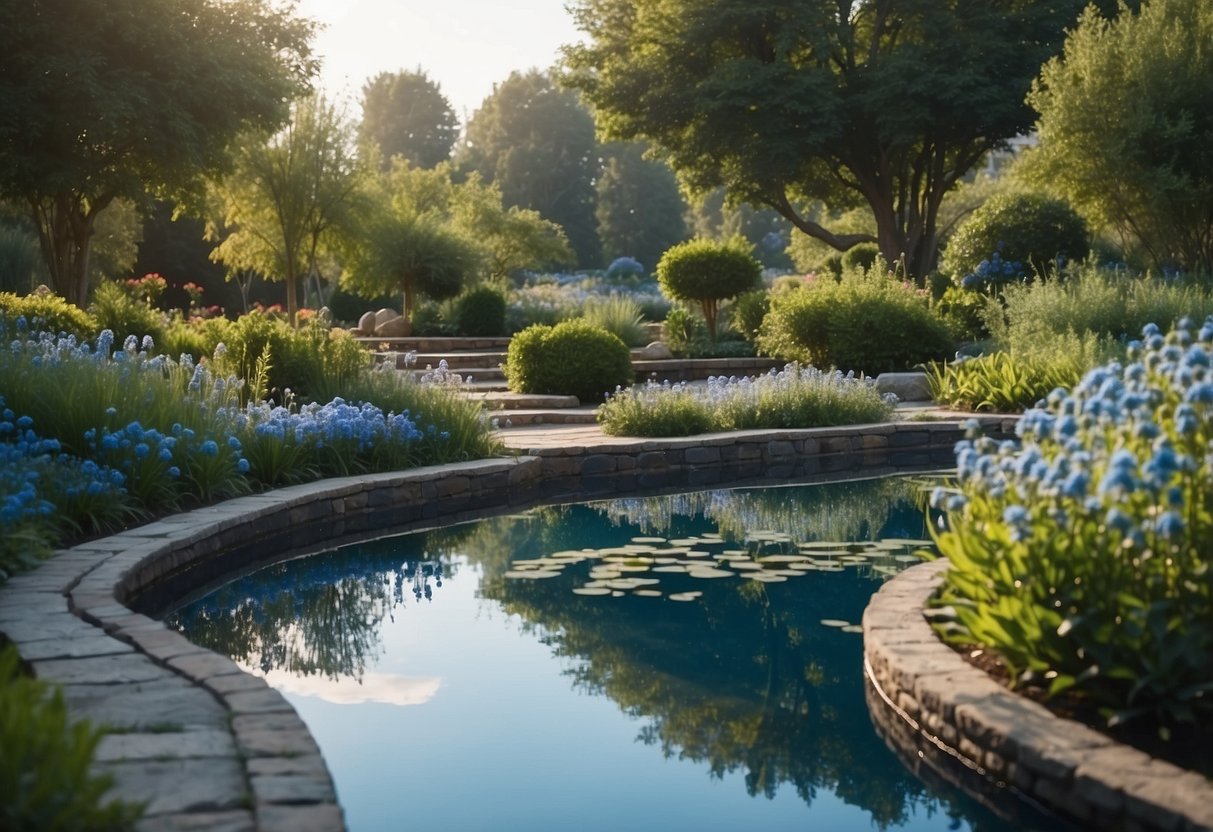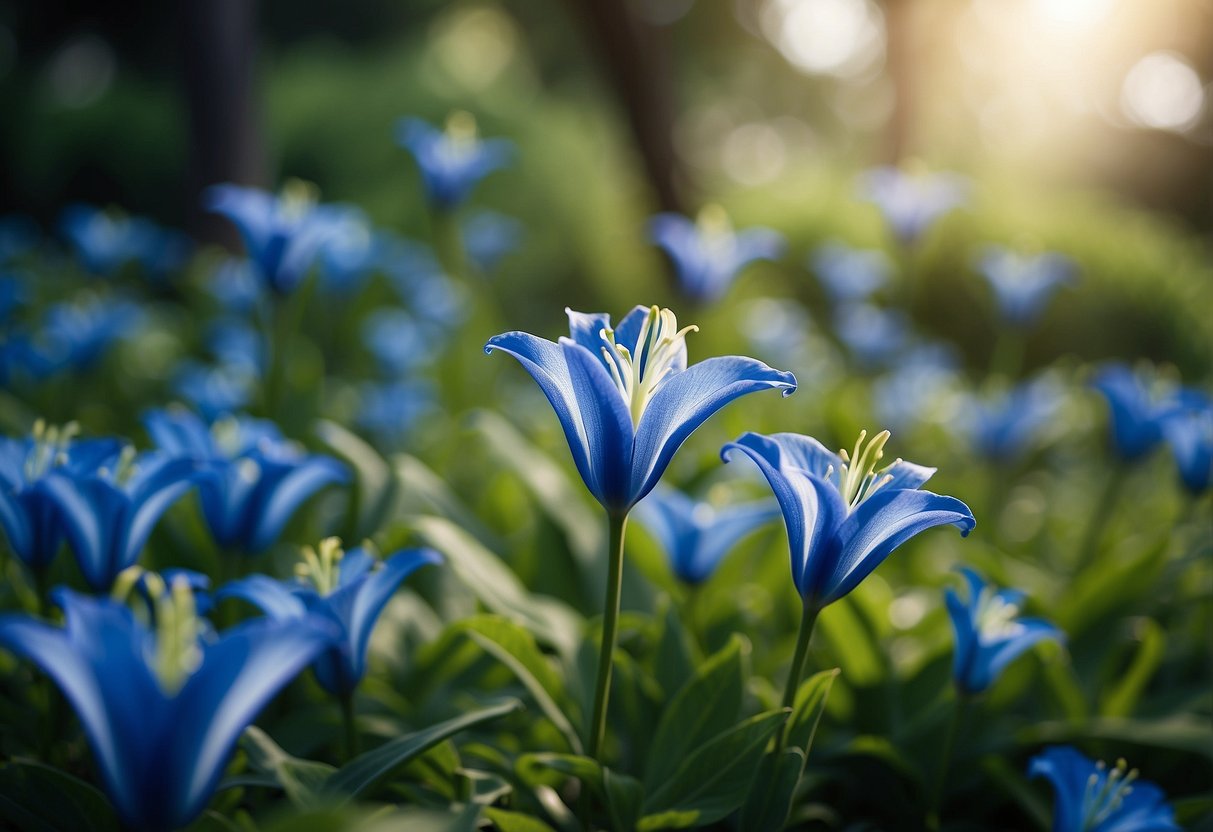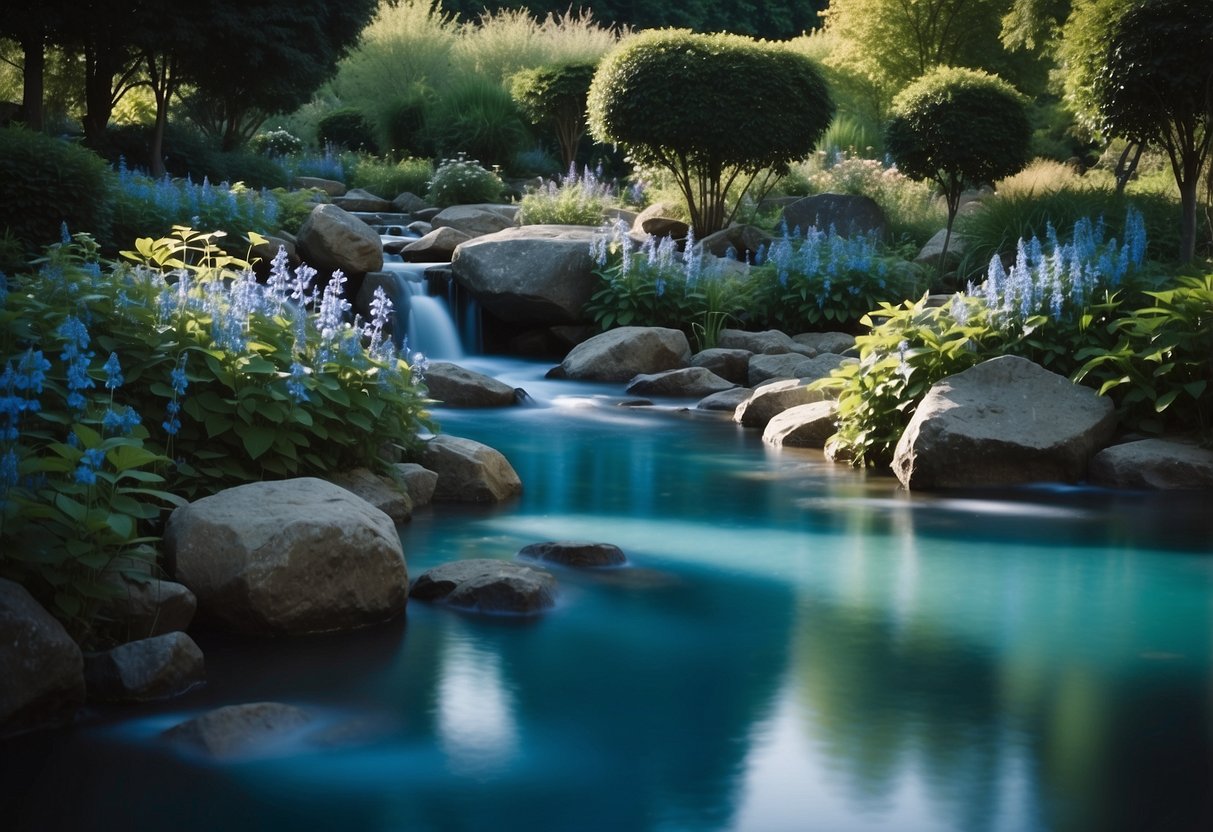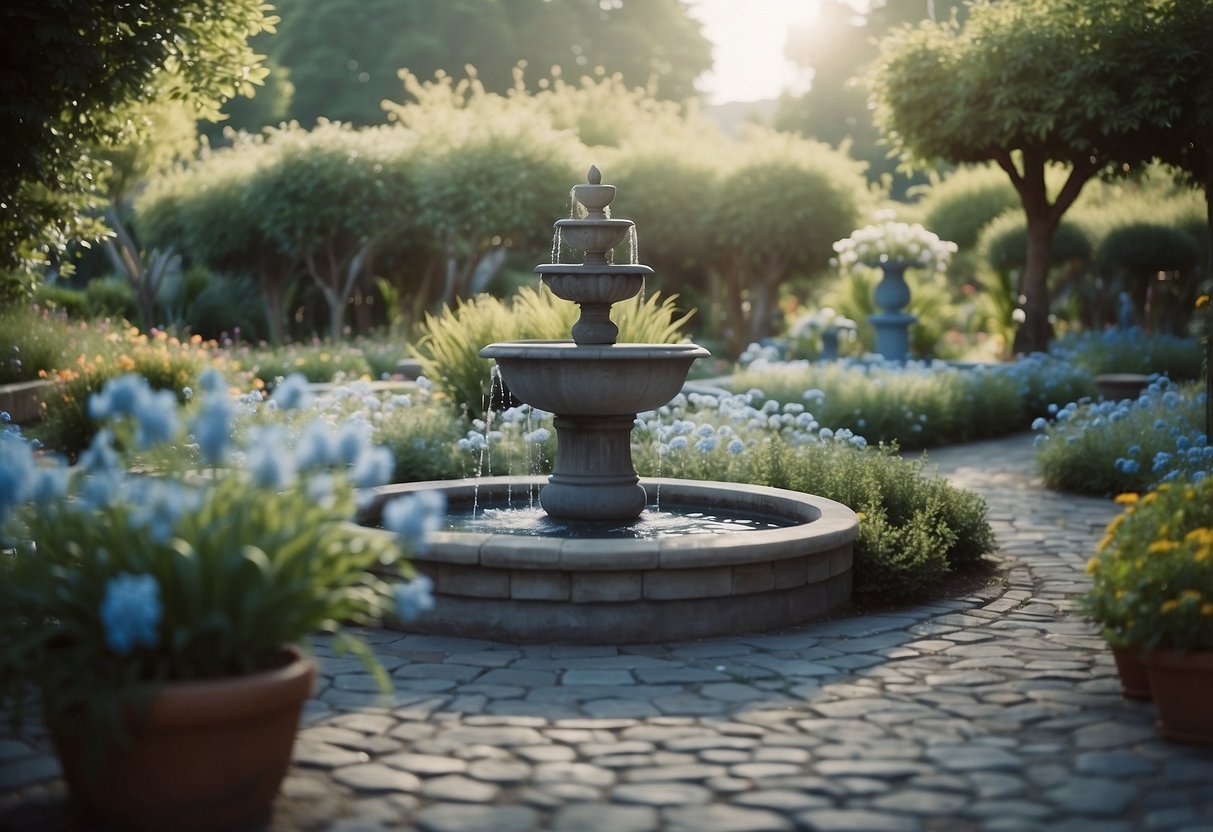Blue Garden Ideas: Create a Tranquil Oasis
Adding a splash of blue to your garden can create a serene and enchanting oasis. Whether you love vibrant cobalt or subtle sky blue, incorporating this color into your outdoor space can have a calming effect. By using blue accents, flowers, and decorations, you can transform your garden into a tranquil retreat.

You don’t need a large space to make a big impact. Even small touches like blue-painted pots or garden art can add personality and charm. From flowers to furniture, there are many ways to weave this cool hue into your garden design.
1) Blue Hydrangeas

Blue hydrangeas are a stunning addition to any garden. Their vibrant blue flowers add a pop of color that can brighten your outdoor space. These plants thrive in acidic soil with a pH of 5.5 or lower.
Choose varieties like ‘Cape Cod’ or ‘Penny Mac’ for easy maintenance and beautiful blooms. These types grow well in pots and can reach heights of up to six feet. Morning sun and afternoon shade are ideal for healthy growth and vibrant color.
Keep your soil fertile and rich in organic matter for the best results. Happy gardening!
2) Blue Star Creeper

Blue Star Creeper is a wonderful choice for creating a vibrant carpet of green in your garden. This charming, low-growing plant is known for its tiny blue flowers that bloom from spring to fall.
When planting Blue Star Creeper, choose a spot that gets partial sunlight. It thrives well in moist, well-drained soil. You can also grow it in pots, just make sure the pot has a drainage hole to prevent waterlogging.
For best results, keep the soil consistently moist, but not overly wet, until the seeds sprout. Typically, the seeds take about 7 to 15 days to germinate.
3) Blue Delphinium

Blue delphiniums are a stunning addition to any garden. They thrive in full sun and well-draining soil. These tall, majestic flowers come in various shades of blue, making them eye-catching.
You’ll attract hummingbirds, butterflies, and bees with blue delphiniums. Some popular varieties include ‘Cobalt Dreams’ and ‘Blue Butterfly.’ Boosting your garden’s beauty is easy with these vibrant blooms.
Plant them in spring or early autumn for the best results. Make sure to add compost to enrich the soil. Enjoy the burst of blue in your garden!
4) Blue Fescue Grass

Blue fescue grass is a great addition to your blue garden. Its silvery blue foliage adds a stunning contrast to other plants. This ornamental grass grows in small clumps, making it perfect for borders and edging.
You’ll love that blue fescue is low-maintenance and drought-tolerant. It thrives in well-drained soil and is hardy in USDA zones 4 to 8. Even in winter, its vibrant blue color persists, providing year-round interest.
Its fine texture makes it a great companion for heavier or more dramatic plants. Consider planting it with colorful flowers for a striking look. Learn more at Better Homes & Gardens
5) Cornflowers

Cornflowers are a perfect choice if you’re dreaming of a blue garden. These lovely blooms are easy to grow and maintain.
Plant cornflower seeds about 1-2 inches apart and lightly cover them with soil. They thrive in well-drained soil with a pH between 6.0 and 7.0.
For the best results, keep the soil moist and place the container in bright, indirect light. Cornflowers can add vibrant blue to your garden, making it a delightful sight. Learn more about cornflower care at Wild Garden Expert.
6) Blue Lily Turf

Blue Lily Turf, also known as Liriope muscari, is a fantastic addition to your garden. It grows in dense clumps with narrow, arching, dark green leaves, providing year-round interest.
During late summer and fall, this perennial produces tall spikes of lavender-blue flowers. These flowers later turn into attractive black berries.
Blue Lily Turf is low-maintenance and works well as ground cover or edging. It can tolerate partial sun and can thrive in zones 5 to 10. Learn more about growing Blue Lily Turf in your garden.
7) Blue Poppy

Adding blue poppies to your garden gives a unique and stunning touch. The cool blue color of their blooms stands out beautifully.
Blue poppies thrive in dappled shade and cool, moist conditions. They can grow up to 3 to 5 feet tall and have striking hairy leaves.
Consider planting them in woodland gardens where they mimic their Himalayan origins. For a detailed guide, visit growing blue poppy plants.
8) Blue Plumbago

Blue Plumbago is a lovely choice for your blue garden. This plant grows clusters of blue, purple, or white flowers that look like phlox. These flowers have a pleasant scent and are perfect for adding a splash of color.
Blue Plumbago thrives in well-drained soil and can grow in slightly acidic or alkaline conditions. It is also moderately drought-tolerant, making it easier to care for.
Keep your Blue Plumbago trimmed to about 3 feet. This helps it stay neat and beautiful. It’s also deer-resistant, which is a great advantage for many gardens.
9) Lobelia

Lobelia is a wonderful addition to your blue garden. It’s known for its beautiful blue flowers that can brighten up any space. There are different types, such as edging lobelia, which is great for borders, and cascading lobelia, which looks stunning in pots or window boxes.
You can plant lobelia in a spot that gets at least 4-6 hours of sunlight. Make sure to space the plants 6-18 inches apart for proper growth. Lobelia tends to thrive in rich, moist soil, making it perfect for adding vibrant color to your garden’s layout.
Learn more about planting and growing lobelia to make the most out of this lovely flower.
10) Blue Spruce

The blue spruce is a wonderful choice for your garden. Its silvery-blue needles bring a striking color to your landscape, making it stand out. You can use this tree as a focal point or plant several for a natural screen.
When planting a blue spruce, pick a sunny spot with well-drained soil. Regular watering is essential, especially when the tree is young.
To protect your blue spruce, apply a layer of organic mulch around its base. This helps keep moisture in and stops weeds from growing around the tree. Remember to leave some space between the mulch and the trunk to prevent rot.
You can learn more about how to plant and care for Colorado Blue Spruce for additional tips!
Choosing the Right Blue Plants

Blue flowers can bring a sense of calm and elegance to your garden. Here’s a guide to help you choose the best blue plants, taking into account whether you prefer annuals or perennials, and popular varieties.
Annuals vs Perennials
When selecting blue plants, decide if you want annuals or perennials. Annuals like Lobelia grow quickly and bloom throughout one season. They’re excellent for filling gaps in containers or window boxes in sunny spots. Annuals need to be replanted each year but can give your garden a fresh look annually.
Perennials, on the other hand, return year after year. This includes plants like the Rozanne Everblooming Geranium and Salvia. Perennials are perfect if you want a lasting impact. They might take time to establish but can offer stunning displays each season.
Top Blue Flower Varieties
Some top blue flower varieties can add color and interest to your garden. The Love-in-a-Mist (Nigella) is known for its delicate sky-blue flowers and unique seed pods, adding a whimsical touch. For attracting bees and butterflies, the large cone flower with its powder-blue blooms is a great pick.
Salvia is an excellent choice if you fight against deer or rabbits—its fragrant foliage keeps these animals at bay, yet pollinators love it. Petunia offers bright and colorful blooms that can make your garden lively. Combining these varieties can give your garden a charming and vibrant blue theme.
Designing a Blue-Themed Garden

Creating a blue-themed garden can be both beautiful and calming. By focusing on color combinations and garden layout tips, you’ll be able to design a garden space that feels cohesive and inviting.
Color Combinations
Choosing the right colors to complement blue is key. Blue flowers like hydrangeas, delphiniums, and lobelias provide varying shades from light to deep blue. Pair these with silver-foliaged plants such as lavender or dusty miller for a striking contrast.
Mixing shades is also important. Combine light blues with deeper tones to add depth. Consider integrating some white or yellow flowers to break the monotony and enhance blue hues. For example, blue forget-me-nots paired with white daisies can create a lively section.
Adding accents with garden art, cushions, and pottery painted in different shades of blue can complete your theme. This adds visual interest and ties your plant choices together, making the space feel unified.
Garden Layout Tips
Think about the placement of your blue-themed plants. Position taller plants like blue delphiniums in the back, with shorter blue blooms like lobelias in the front. This creates layers and helps showcase each plant.
Pathways and garden edges can be lined with blue-flowered plants. This not only guides visitors but also maintains the blue theme throughout the garden. Use potted plants in Klein blue to highlight specific areas or create focal points.
Don’t forget about lighting. Soft, blue-toned lights can enhance your garden’s atmosphere as the sun sets. Place lights near key features to draw attention and keep the garden inviting. This small touch can make a big difference in your garden’s overall appeal.
You can find more tips for designing your garden with blue colors at Gardenia and Gardening Know How.
Maintenance Tips

Keeping your blue garden vibrant and healthy requires a few key practices. Focus on regular watering, proper soil care, and vigilant pest control to maintain a stunning display of blue blooms.
Watering and Soil Care
Blue flowering plants such as hydrangeas, salvia, and bluebells need consistent watering to thrive. Hydrangeas, for example, prefer moist but well-drained soil, meaning the soil should stay damp but not waterlogged.
To avoid root rot, make sure the garden bed has good drainage. Adding compost can improve soil structure and water retention. Use mulch around plants to retain moisture and reduce the need for frequent watering.
A simple drip irrigation system can provide steady moisture directly to the roots, saving you both time and water. Consider the specific needs of each blue plant, as some might require more frequent watering than others.
Pest Control
Pests can damage your blue garden if not managed properly. Common pests include aphids, slugs, and caterpillars.
Aphids can be controlled by introducing natural predators like ladybugs. Slugs can be deterred by placing crushed eggshells or copper tape around your plants.
Regularly inspect your plants for signs of pests. Yellowing leaves or holes can indicate an infestation. You can use organic pesticides or insecticidal soap as a treatment. Alternatively, planting pest-resistant blue flowers, such as bachelor’s buttons, can also help maintain a healthy garden.
By employing these tips, your blue garden should thrive with minimal fuss.







